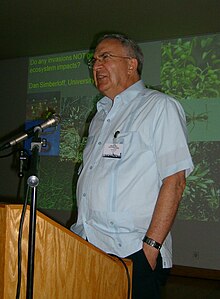Daniel Simberloff
| Daniel Simberloff | |
|---|---|

Simberloff at BIOLIEF conference on October 27, 2009
|
|
| Born | 1942 (age 74–75) Wilson, Pennsylvania, United States |
| Nationality | American |
| Fields | Biology |
| Institutions |
University of Tennessee University of South Florida |
| Alma mater | Harvard University |
| Doctoral advisor | E. O. Wilson |
| Known for | Invasion biology |
Daniel Simberloff is a biologist and ecologist who earned his Ph.D. from Harvard University in 1969. He is currently Gore Hunger Professor of Environmental Science at the University of Tennessee and Editor-in-chief of the journal Biological Invasions.
Simberloff was born in 1942 in Wilson Borough, Pennsylvania, a small town near the Delaware River. As a young child, he collected insects, especially beetles, pinning and preserving them in cigar boxes as early as four years old. In addition to his collection of insects, Simberloff also caught and kept salamanders and musk turtles in a basin in his home. He cites being influenced by his uncle, who was a chemist. Consequently, he received science books and was taken to science lectures throughout his youth. He moved to New York City at age 11. Simberloff recalls really enjoying all school subjects, math in particular, despite the substandard teaching of the large underfunded city schools. He excelled in everything academic.
Simberloff received his A.B. from Harvard College in 1964, and later received his Ph.D. in Biology from Harvard University in 1969. He wanted to go to grad school for mathematics, but changed his mind after taking a major biology course as an undergrad. This led to his introduction to Edward O. Wilson. Simberloff became Wilson’s grad student, which began his career in ecology.
Simberloff studied and collaborated with E. O. Wilson with many textbooks and experimental studies to assess the theory of island biogeography . This won them the Mercer Award in 1971. He was questioned after his 1976 Science paper, where he contradicted his own theory. He claimed that most of the insect turnover in this assemblage was ephemeral and did not, therefore, confirm the theory. This was interesting in the sense that he was confident enough to question his own theory even after it was widely accepted. Society embraced his island biogeography, and it was used in designing nature reserves. Simberloff questioned the reserves, claiming large reserves aren’t always the best choice and in some cases small reserves might be better. In the early 80’s, Simberloff took on the MacArthurian paradigm of competitively structured communities. He championed the use of null models in community ecology. This changed the face of the field. He caused ecologists to question, “what would happen if one mechanism were removed?” He preached, “rely on the data to tell you how nature operates; don’t simply find the patterns that you’re supposed to find.” He was instrumental in making the presidential Executive order 13112 on invasive species, and he also serves on the IUCN Invasive Species Specialist Group and the IUCN Species Survival Commission.
...
Wikipedia
